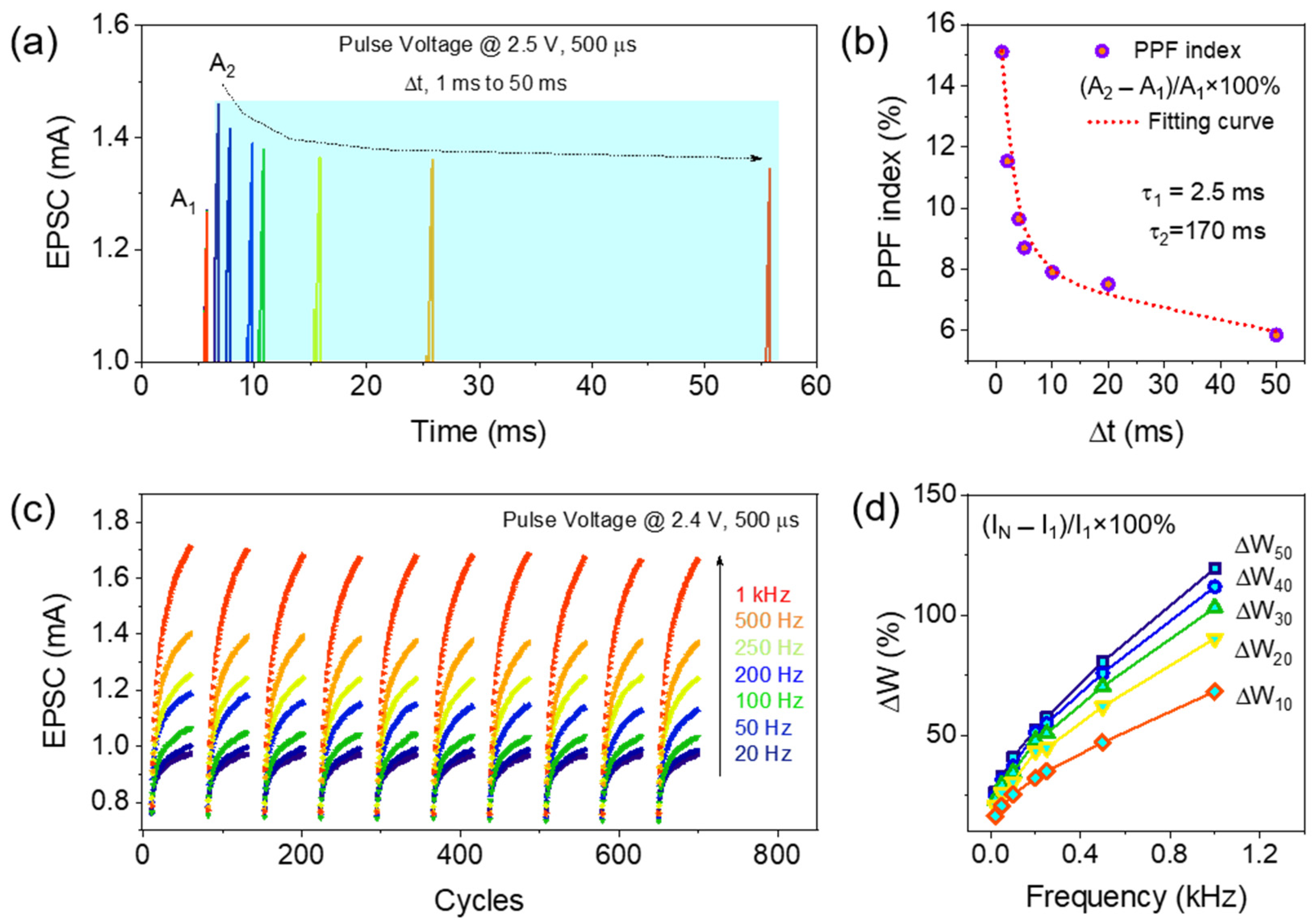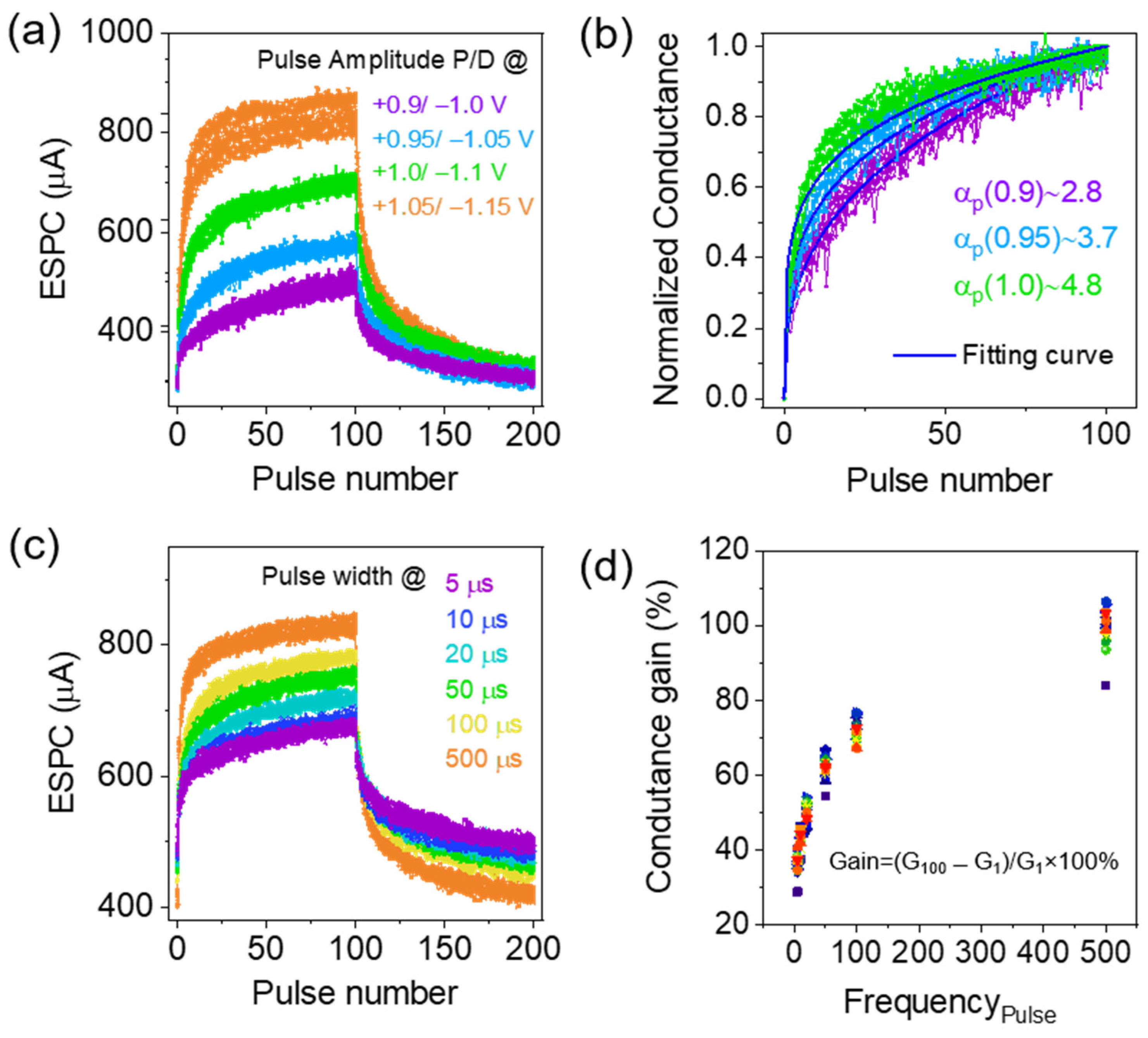Analog Memory and Synaptic Plasticity in an InGaZnO-Based Memristor by Modifying Intrinsic Oxygen Vacancies
Abstract
:1. Introduction
2. Materials and Methods
3. Results and Discussion
3.1. Charge Trapping and Soft-Breakdown Characteristics of ITO/InGaZnO/ITO Memristor
3.2. Gradual Bipolar Resistive Switching of ITO/InGaZnO/ITO Memristor
3.3. Pulse Amplitude-Dependent Short-Term and Long-Term Synaptic Weight Modulation
3.4. PPF and Pulse Frequency-Dependent Synaptic Properties
3.5. Pulse Amplitude and Width-Dependent Long-Term Potentiation Properties
4. Conclusions
Author Contributions
Funding
Institutional Review Board Statement
Informed Consent Statement
Data Availability Statement
Conflicts of Interest
References
- Waser, R.; Dittmann, R.; Staikov, C.; Szot, K. Redox-based resistive switching memories nanoionic mechanisms, prospects, and challenges. Adv. Mater. 2009, 21, 2632–2663. [Google Scholar] [CrossRef]
- Yang, J.J.; Strukov, D.B.; Stewart, D.R. Memristive devices for computing. Nat. Nanotechnol. 2013, 8, 13–24. [Google Scholar] [CrossRef] [PubMed]
- He, Y.; Jiang, S.; Chen, C.; Wan, C.; Shi, Y.; Wan, Q. Electrolyte-gated neuromorphic transistors for brain-like dynamic computing. J. Appl. Phys. 2021, 130, 190904. [Google Scholar] [CrossRef]
- Shang, J.; Liu, G.; Yang, H.; Zhu, X.; Chen, X.; Tan, H.; Hu, B.; Pan, L.; Xue, W.; Li, R.W. Thermally stable transparent resistive random access memory based on all-oxide heterostructures. Adv. Funct. Mater. 2014, 24, 2171–2179. [Google Scholar] [CrossRef]
- Tarsoly, G.; Lee, J.Y.; Shan, F.; Kim, S.J. Switching facilitated by the simultaneous formation of oxygen vacancies and conductive filaments in resistive memory devices based on thermally annealed TiO2/a-IGZO bilayers. Appl. Surf. Sci. 2022, 601, 154281. [Google Scholar] [CrossRef]
- Kumar, A.; Krishnaiah, M.; Mishra, D.; Jo, H.; Jin, S.H. Role of IGZO thickness for oxygen reservoir control in stacked IGZO/ZrOx layers: Towards reliable, uniform performance of flexible random-access memories. J. Alloys Compd. 2022, 922, 166199. [Google Scholar] [CrossRef]
- Mahata, C.; Park, J.; Ismail, M.; Kim, S. Demonstration of electronic and optical synaptic properties modulation of reactively sputtered zinc-oxide-based artificial synapses. J. Alloys Compd. 2023, 938, 168539. [Google Scholar] [CrossRef]
- Qin, F.; Zhang, Y.; Park, H.; Kim, C.S.; Lee, D.H.; Jiang, Z.T.; Park, J.; No, K.; Park, H.; Song, H.W.; et al. Factors Determining the Resistive Switching Behavior of Transparent InGaZnO-Based Memristors. Phys. Status Solidi Rapid Res. Lett. 2022, 16, 2200075. [Google Scholar] [CrossRef]
- Zhang, L.; Xu, Z.; Han, J.; Liu, L.; Ye, C.; Zhou, Y.; Xiong, W.; Liu, Y.; He, G. Resistive switching performance improvement of InGaZnO-based memory device by nitrogen plasma treatment. J. Mater. Sci. Technol. 2020, 49, 1–6. [Google Scholar] [CrossRef]
- Hu, W.; Zou, L.; Chen, X.; Qin, N.; Li, S.; Bao, D. Highly uniform resistive switching properties of amorphous InGaZnO thin films prepared by a low temperature photochemical solution deposition method. ACS Appl. Mater. Interfaces 2014, 6, 5012–5017. [Google Scholar] [CrossRef]
- Li, Q.; Li, Y.; Gao, L.; Ma, F.; Song, Z.; Xu, K. Ru doping enhanced resistive switching behavior in InGaZnO thin films. RSC Adv. 2016, 6, 42347–42352. [Google Scholar] [CrossRef]
- Mahata, C.; Park, J.; Ismail, M.; Kim, D.H.; Kim, S. Improved Resistive Switching with Low-Power Synaptic Behaviors of ZnO/Al2O3 Bilayer Structure. Materials. 2022, 15, 6663. [Google Scholar] [CrossRef]
- Mahata, C.; Pyo, J.; Jeon, B.; Ismail, M.; Kang, M.; Kim, S. Forming-Free Tunable Analog Switching in WOx/TaOx Heterojunction for Emulating Electronic Synapses. Materials 2022, 15, 8858. [Google Scholar] [CrossRef] [PubMed]
- Choi, W.S.; Jang, J.T.; Kim, D.; Yang, T.J.; Kim, C.; Kim, H.; Kim, D.H. Influence of Al2O3 layer on InGaZnO memristor crossbar array for neuromorphic applications. Chaos Solitons Fractals 2022, 156, 111813. [Google Scholar] [CrossRef]
- Sokolov, A.S.; Jeon, Y.R.; Ku, B.; Choi, C. Ar ion plasma surface modification on the heterostructured TaOx/InGaZnO thin films for flexible memristor synapse. J. Alloys Compd. 2020, 822, 153625. [Google Scholar] [CrossRef]
- Ma, P.; Liang, G.; Wang, Y.; Li, Y.; Xin, Q.; Li, Y.; Song, A. High-performance InGaZnO-based ReRAMs. IEEE Trans. Electron Devices 2019, 66, 2600–2605. [Google Scholar] [CrossRef]
- Choi, S.; Kim, J.Y.; Kang, H.; Ko, D.; Rhee, J.; Choi, S.J.; Kim, D.M.; Kim, D.H. Effect of oxygen content on current stress-induced instability in bottom-gate amorphous InGaZnO thin-film transistors. Materials 2019, 12, 3149. [Google Scholar] [CrossRef] [PubMed]
- Gonzalez, M.B.; Rafí, J.M.; Beldarrain, O.; Zabala, M.; Campabadal, F. Charge trapping and electrical degradation in atomic layer deposited Al2O3 films. Microelectron. Eng. 2013, 109, 57–59. [Google Scholar] [CrossRef]
- Jeon, H.U.; Cho, W.J. Fully transparent and sensitivity-programmable amorphous indium-gallium-zinc-oxide thin-film transistor-based biosensor platforms with resistive switching memories. Sensors 2021, 21, 4435. [Google Scholar] [CrossRef] [PubMed]
- Li, Z.; Tian, B.; Xue, K.H.; Wang, B.; Xu, M.; Lu, H.; Sun, H.; Miao, X. Coexistence of digital and analog resistive switching with low operation voltage in oxygen-gradient HfOx Memristors. IEEE Electron Device Lett. 2019, 40, 1068–1071. [Google Scholar] [CrossRef]
- Ji, X.; Wang, C.; Lim, K.G.; Tan, C.C.; Chong, T.C.; Zhao, R. Tunable Resistive Switching Enabled by Malleable Redox Reaction in the Nano-Vacuum Gap. ACS Appl. Mater. Interfaces 2019, 11, 20965–20972. [Google Scholar] [CrossRef] [PubMed]
- Li, Y.; Zhong, Y.; Zhang, J.; Xu, L.; Wang, Q.; Sun, H.; Tong, H.; Cheng, X.; Miao, X. Activity-Dependent Synaptic Plasticity of a Chalcogenide Electronic Synapse for Neuromorphic Systems. Sci. Rep. 2014, 4, 4906. [Google Scholar] [CrossRef] [PubMed]
- Kim, S.G.; Han, J.S.; Kim, H.; Kim, S.Y.; Jang, H.W. Recent Advances in Memristive Materials for Artificial Synapses. Adv. Mater. Technol. 2018, 3, 1800457. [Google Scholar] [CrossRef]
- Zhong, Y.; Wang, T.; Gao, X.; Xu, J.; Wang, S. Synapse-Like Organic Thin Film Memristors. Adv. Funct. Mater. 2018, 28, 1800854. [Google Scholar] [CrossRef]
- Yang, F.S.; Li, M.; Lee, M.P.; Ho, I.Y.; Chen, J.Y.; Ling, H.; Li, Y.; Chang, J.K.; Yang, S.H.; Chang, Y.M.; et al. Oxidation-boosted charge trapping in ultra-sensitive van der Waals materials for artificial synaptic features. Nat. Commun. 2020, 11, 2972. [Google Scholar] [CrossRef]
- Zhu, L.Q.; Wan, C.J.; Guo, L.Q.; Shi, Y.; Wan, Q. Artificial synapse network on inorganic proton conductor for neuromorphic systems. Nat. Commun. 2014, 5, 3158. [Google Scholar] [CrossRef] [PubMed]
- Hu, W.; Jiang, J.; Xie, D.; Liu, B.; Yang, J.; He, J. Proton-electron-coupled MoS2 synaptic transistors with a natural renewable biopolymer neurotransmitter for brain-inspired neuromorphic learning. J. Mater. Chem. C 2019, 7, 682–691. [Google Scholar] [CrossRef]
- Mou, X.; Tang, J.; Lyu, Y.; Zhang, Q.; Yang, S.; Xu, F.; Liu, W.; Xu, M.; Zhou, Y.; Sun, W.; et al. Analog memristive synapse based on topotactic phase transition for high-performance neuromorphic computing and neural network pruning. Sci. Adv. 2021, 7, eabh0648. [Google Scholar] [CrossRef] [PubMed]
- Majumdar, S.; Tan, H.; Pande, I.; Van Dijken, S. Crossover from synaptic to neuronal functionalities through carrier concentration control in Nb-doped SrTiO3-based organic ferroelectric tunnel junctions. APL Mater. 2019, 7, 091114. [Google Scholar] [CrossRef]
- Zhang, Y.; Liu, L.; Tu, B.; Cui, B.; Guo, J.; Zhao, X.; Wang, J.; Yan, Y. An artificial synapse based on molecular junctions. Nat. Commun. 2023, 14, 247. [Google Scholar] [CrossRef]
- El Mesoudy, A.; Lamri, G.; Dawant, R.; Arias-Zapata, J.; Gliech, P.; Beilliard, Y.; Ecoffey, S.; Ruediger, A.; Alibart, F.; Drouin, D. Fully CMOS-compatible passive TiO2-based memristor crossbars for in-memory computing. Microelectron. Eng. 2022, 255, 111706. [Google Scholar] [CrossRef]
- Li, S.; Li, B.; Feng, X.; Chen, L.; Li, Y.; Huang, L.; Fong, X.; Ang, K.W. Electron-beam-irradiated rhenium disulfide memristors with low variability for neuromorphic computing. NPJ 2D Mater. Appl. 2021, 5, 1. [Google Scholar] [CrossRef]
- Sahu, D.P.; Park, K.; Chung, P.H.; Han, J.; Yoon, T.S. Linear and symmetric synaptic weight update characteristics by controlling filament geometry in oxide/suboxide HfOx bilayer memristive device for neuromorphic computing. Sci. Rep. 2023, 13, 9592. [Google Scholar] [CrossRef] [PubMed]
- Byun, K.; Choi, I.; Kwon, S.; Kim, Y.; Kang, D.; Cho, Y.W.; Yoon, S.K.; Kim, S. Recent Advances in Synaptic Nonvolatile Memory Devices and Compensating Architectural and Algorithmic Methods Toward Fully Integrated Neuromorphic Chips. Adv. Mater. Technol. 2022, 8, 2200884. [Google Scholar] [CrossRef]
- Mahata, C.; Pyo, J.; Jeon, B.; Ismail, M.; Moon, J.; Kim, S. Improved synaptic performances with tungsten-doped indium-tin-oxide alloy electrode for tantalum oxide-based resistive random-access memory devices. Adv. Compos. Hybrid Mater. 2023, 6, 144. [Google Scholar] [CrossRef]
- Jang, J.W.; Park, S.; Burr, G.W.; Hwang, H.; Jeong, Y.H. Optimization of conductance change in Pr1-xCaxMnO3-based synaptic devices for neuromorphic systems. IEEE Electron Device Lett. 2015, 36, 457–459. [Google Scholar] [CrossRef]





| Device Structure | SET/RESET (V) | Endurance Cycles | Memory Window | Multilevel Switching | Switching Behaviors | Synaptic Properties | Reference |
|---|---|---|---|---|---|---|---|
| Ag/a-IGZO/TiO2/ ITO | +1.5/−1.5 | 250 | <10 | No | Analog | No | [5] |
| ITO/IGZO/ ZrOx/Ti | −2.4/+2.3 | 103 | ~100 | No | Analog | No | [6] |
| ITO/IGZO/ ITO | +4.0/−3.8 | 50 | ~10 | No | Digital | No | [8] |
| Pt/IGZO/ IGZO:N/TiN | +0.75/−0.75 | 100 | ~100 | No | Analog | No | [9] |
| Pt/a-IGZO/Pt | +1.6/−1.0 | 100 | ~10 | No | Digital | No | [10] |
| Ag/IGZO (Ru)/Pt | +0.25/−0.6 | 50 | ~104 | No | Digital | No | [11] |
| Mo/Al2O3/ IGZO/Pd | +5.1/−4.8 | 500 | >10 | No | Analog | No | [14] |
| Ti/TaOx/ IGZO/Pt | +0.75/−0.9 | 50 | 103 | Yes | Analog | No | [15] |
| Al/IGZO/Al2O3/Al | +2.3/−0.6 | 100 | 104 | Digital | No | [16] | |
| ITO/IGZO/ ITO | +1.0/−1.0 | 100 | ~102 | Yes | Analog | Yes | This study |
Disclaimer/Publisher’s Note: The statements, opinions and data contained in all publications are solely those of the individual author(s) and contributor(s) and not of MDPI and/or the editor(s). MDPI and/or the editor(s) disclaim responsibility for any injury to people or property resulting from any ideas, methods, instructions or products referred to in the content. |
© 2023 by the authors. Licensee MDPI, Basel, Switzerland. This article is an open access article distributed under the terms and conditions of the Creative Commons Attribution (CC BY) license (https://creativecommons.org/licenses/by/4.0/).
Share and Cite
Mahata, C.; So, H.; Kim, S.; Kim, S.; Cho, S. Analog Memory and Synaptic Plasticity in an InGaZnO-Based Memristor by Modifying Intrinsic Oxygen Vacancies. Materials 2023, 16, 7510. https://doi.org/10.3390/ma16247510
Mahata C, So H, Kim S, Kim S, Cho S. Analog Memory and Synaptic Plasticity in an InGaZnO-Based Memristor by Modifying Intrinsic Oxygen Vacancies. Materials. 2023; 16(24):7510. https://doi.org/10.3390/ma16247510
Chicago/Turabian StyleMahata, Chandreswar, Hyojin So, Soomin Kim, Sungjun Kim, and Seongjae Cho. 2023. "Analog Memory and Synaptic Plasticity in an InGaZnO-Based Memristor by Modifying Intrinsic Oxygen Vacancies" Materials 16, no. 24: 7510. https://doi.org/10.3390/ma16247510







